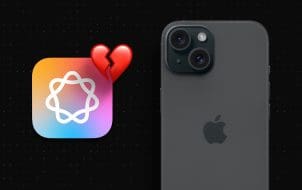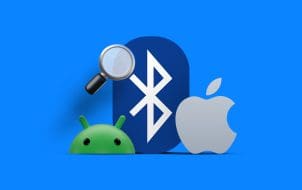Setting up your new iPhone may seem like a mammoth task, especially if you need to transfer data and files from your old phone to your new phone. But don’t worry; you’re not alone.
In this article, we’ll cover everything you need to know about getting your new iPhone up and running. That way, you can enjoy your device to the full.
Setting Up Your iPhone 15
Here’s what you don’t know about the new iPhone 15 and 15 Pro: They’re not set up with a physical SIM card. You’ll need to use an e-SIM (electronic SIM card).
If you don’t need to transfer any data and you only want to activate your new iPhone 15 or 15 Pro, then follow these steps:
- Power the phone on and swipe up to select the region and country. Then, select the screen size.

- Connect to your Wi-Fi, then read and accept the Data and Privacy statement.

- Next, set up your FaceTime ID, enter a six-digit passcode, and then create your Apple ID or input your existing Apple ID. Finally, read and approve the terms and conditions.

- You can either select “Continue” and follow the steps. Alternatively, select “Not Now” and skip these steps. They include iMessage and FaceTime, Location settings, the Apple Pay Wallet, Siri, Weekly Reports, and iPhone Analytics.

- Next, you can select the appearance of your screen, which includes either a light or a dark screen and the display zoom of your screen.
Voila! You’re all set up and ready to start using your new iPhone 15 or 15 Pro!
Data Transfer
If you’re planning on transferring data between your old and new phone, you’ll need the following:
- Wi-Fi or data
- Your Apple or Google account information
- Your old phone and your new iPhone 15 or 15 Pro
- Both cell phones must be fully charged
Data backup should always be your first step. Once you have your data backed up, your next step is to set up your new phone and move your photos, contacts, and other data. Before you proceed, however, check that both phones are fully charged and connected to the internet through Wi-Fi.
Setup Your Old Phone for Data Transfer
If your old phone is an Android, you’ll need to download an app from the Google Play Store to transfer your data from your Android to your iPhone. Follow these steps:
- Open the Google Play Store on your Android phone.

- Then, download and install the “Move to IOS” app.

- After downloading the app, tap “Continue, Agree” and then “Next.”

- Next, switch on your iPhone, and follow the setup instructions until you reach the screen that says “Apps and Data.”

- Select “Move Data from Android” and then “Continue.”

- A six to nine-digit code will appear on the screen. Insert this code in the “Move to IOS” app located on your old phone.

- You’ll notice a “Data Transfer” screen appear on your old phone. From here, you can choose which data you would like to transfer to your new phone. Once you’ve made your selection, tap “Continue.”

- Allow the data to transfer without interfering with or touching the phone. When the loading bar is full, you may select “Done.”

- Then, select “Continue” on your iPhone. Follow the final setup instructions on your iPhone 15 or 15 Pro.

Well done! You’re all set up!
Back Up Your Data
Your old phone holds all your memories and other important data. Before you start, it’s imperative that you back this data up. If anything happens, and you lose these files in the process, you’ll have a backup to restore it from. Hence, backing up your phone data is a crucial step that you absolutely can’t ignore.
If your old phone is an Android, follow these steps:
- Open the Google Drive app on your phone.

- Go to the Menu Bar and select “Settings” then select “Backup and Reset.”

- Your Google Account must be listed. Then select “Backup Now” and allow the process to run to completion.

If your old phone is an iPhone, then follow these steps:
- Select “Settings” in the Menu Bar then select “iCloud” and “iCloud Backup.”

- Then, turn on “iCloud Backup.”

- On a side note, your iPhone will automatically back up all your data if it’s connected to the power and Wi-Fi.
FAQs
Can I set up my iPhone without Wi-Fi?
Yes, you’ll be able to setup your new phone without connecting to the internet. However, if you need to back up your data and transfer it to your new phone, you’ll need to have Wi-Fi activated on both phones, and both phones will need a full charge.
What is Quick Start and how does it work?
Quick Start is an Apple product feature that allows you to quickly transfer data from your old iPhone device to your new phone. For example, if you’d like to transfer data from your old iPad to your new phone, you can use Quick Start. A quick side note, you’ll need iOS 11, iPadOS 13 , or later versions in order to use Quick Start. All you have to do is bring your devices close to each other and the process will activate.
What do I do if I don’t have sufficient storage space for a backup?
Great news! iCloud offers users additional storage, free of charge, for up to three weeks. This feature is temporary and is aimed at assisting users while they make arrangements for additional storage. To access this feature simply follow these prompts . Go to “Settings” on your old device, then tap on “General,” and then “Transfer or Reset.”
What is the latest version of iOS?
The latest version is iOS 17.
What if my iPhone is a company phone? Are the setup instructions still the same?
Yes. However, you’ll need to visit the Apple At Work website and follow their instructions to set your phone up.
Ready, Set, Use Phone
It’s important to properly set up your device as quickly as possible to enjoy the benefits your new phone offers. It will save you time and effort in the long run. Your Apple iPhone includes a series of unique apps and features that make it one of the industry-leading products.
Have you just set up your iPhone? If so, did you use any of the tips and tricks in this article? Let us know in the comments section below.
Disclaimer: Some pages on this site may include an affiliate link. This does not effect our editorial in any way.

























